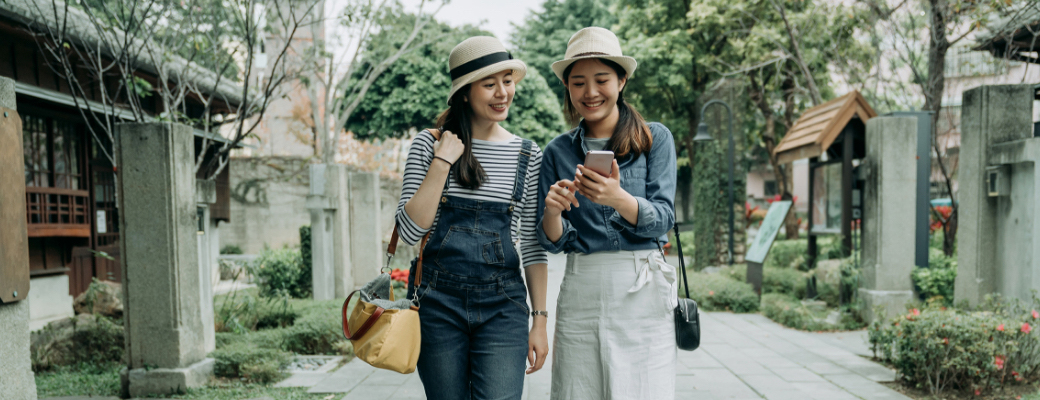
Digital Ticket
On sale: a set ticket including the Rapi:t , admission to the Tsutenkaku Observation Deck, and Nankai Soba!

A temple? A shrine? What’s the difference?
Although both are familiar to Japanese people, temples and shrines are actually very similar and different. It may be surprisingly difficult to explain the differences. This article will explain in detail the differences between temples and shrines, focusing on the method of worship, the buildings, and the people who work there.
First, let's look at the definitions of temple and shrine. Temples and shrines differ in their religious beliefs.
What is a temple?
"Buddhism" is what the temple believes in. Buddhism is a religion founded by Buddha (Shakyamuni), who was born in ancient India. It was introduced to Japan from the continent via China.
A temple is positioned as a place where monks who believe in such Buddhism learn its doctrines and practice.
What is a shrine?
"Shinto" is what the shrine believes in. Shinto is an ancient Japanese religion. The Shinto concept of "eight million (yaoyorozu) gods" is that all beings, such as nature, people, objects, and land, are worshipped as gods.
Shrines that enshrine each of the deities worshipped are also considered to be places where the deities reside.
Since the religions believed in are different between Buddhism and Shintoism, there are differences in the way of worship between temples and shrines.
At temples, after offering money, the worshippers join their hands together in front of their chests and clasp their palms together. It is considered good manners not to clap.
At shrines, the basic rule is "bow twice, clap twice, and bow once". After offering money, bow twice, clap your hands twice, and bow once at the end.
What is enshrined at temples and shrines is also different. Temples enshrine Buddhist statues, while shrines enshrine sacred objects. The major difference is whether people can see them or not.
In most cases, you can see the Buddha images enshrined in temples, but in shrines, the go-shintai is enshrined in a place that cannot be seen from the outside.
And there is a difference between those who work at temples and shrines.
People who work at temples are called "monks" or "obosan" . They give sutras and perform ascetic practices that record the teachings preached by the Buddha. Funerals and the management of temples and cemeteries are also the work of monks and priests.
Those who work at shrines are called "shinshoku" or "kannushi". Their main work is to perform rituals, company duties, and prayers held at shrines. Incidentally, "miko," or shrine maidens, who are often seen at shrines, are women who assist the priests and perform kagura (Shinto music and dance) during Shinto rituals.
The difference between temples and shrines is also expressed in their buildings.
Temples are largely divided into "garan" and monks' quarters. A garan is a place where objects of worship such as Buddhist statues are enshrined. The monks' quarters are where the monks live. Generally, a "sangmon" is located at the entrance, and a "pagoda" representing the Buddha and a "kondo" where Buddhist statues are enshrined are located inside the structure.
Shrines, on the other hand, generally have a "torii" gate at the entrance, a "tezumisha" to purify oneself by the side of the "approach," and a "honden" where the deities are enshrined further in the back. Compared to temples, there are fewer types of buildings, and the structure is simpler.
Finally, here are the main temples and shrines that can be visited along the Nankai line.
Sumiyoshi-Taisha
Sumiyoshi-jinja is the head shrine of the 2,300 or so Sumiyoshi shrines in Japan. Known locally as "Sumiyosan" in Osaka, the shrine has long been beloved by the locals. It is also famous throughout Japan for the more than 2.3 million people who visit the shrine at the beginning of each year.
Hochigai Shrine
Located on the border of the three provinces of Settsu, Kawachi, and Izumi, the shrine is said to be "a pure land without direction. The shrine is revered as a deity that protects people from disasters caused by each direction.
Imamiya Ebisu Shrine
Ebisu, the god of prosperity, is enshrined at this shrine. Tooka Ebisu, held over three days from January 9 to 11 every year, is a very popular festival, attracting about one million visitors each year.
Mozu Hachimangu shrine
This is a shrine with a long history, said to have been founded in the Yamato period, around the time of Emperor Kinmei. The shrine pavilion is one of the largest in the prefecture. Here, visitors can draw a "haniwa mikuji" (fortune) in a cute container resembling a haniwa (clay figurine) for a starting fee of 1,000 yen. The "Tsukimisai (moon-viewing) Festival" held every year on the 15th day of the 8th lunar month is also famous, and the powerful "futon-daiko" dedication ceremony is well worth seeing.
Inunakisan Shippoyuryuji Temple
The main temple of the Inunaki school of the Shingon sect, located on Mt. Inunaki, known as the oldest fundamental center of Shugendo in Japan. It is said that Kobo Daishi enshrined seven treasures such as gold and silver in seven waterfalls, and that worshippers can obtain the blessings of Fudo Myoo and all seven gods of good fortune by visiting the temple. On the 28th day of every month, which is Fudo Myoo's lucky day, you can draw the "Fudo Omikuji", which is only available on the 28th, so it is recommended to visit the temple at the right time.
Koyasan Okunoin
This is the sacred site where Kobo Daishi entered the temple. Along the 2-kilometer path from Ichinobashi Bridge to the mausoleum, more than 200,000 gravestones of lords, memorial towers, and cenotaphs stand side by side in a cedar grove.
Kongozan Katsuragi Shrine
The shrine is located near the summit of Mount Kongo, which traverses the border between Osaka and Nara prefectures. Currently, it enshrines 38 shrines of Kuzugi, the guardian deity of Mt. Mt. Kongo has long been considered a sacred mountain of "Shintoism-Buddhism mixture" that combines and harmonizes the two faiths of Shintoism and Buddhism.
In this issue, we explained the differences between temples and shrines. Both are familiar places, but you may have learned something new about them. It seems that it is also important to understand the differences in the religions they believe in and the things they enshrine before making a visit to a shrine.
If you visit temples with the differences introduced here in mind, you may discover something new. We encourage you to visit temples and shrines along the Nankai Line.

